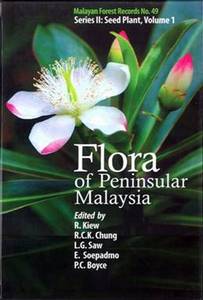Myricaceae
Phoon, S.N. (2010) Myricaceae. In: Kiew, R., Chung, R.C.K., Saw, L.G., Soepadmo, E., and Boyce, P.C., (eds.) Flora of Peninsular Malaysia: Series II: Seed Plant. Malayan Forest Records, 1 . Forest Research Institute Malaysia, Kepong, Malaysia, pp. 145-149.
![[img]](https://researchonline.jcu.edu.au/16588/1.hassmallThumbnailVersion/16588_Phoon_2010_Book_Cover.jpg)
|
Image (JPEG) (Book Cover)
- Cover Image
Download (18kB) |
|
|
PDF (Published Version)
- Published Version
Restricted to Repository staff only |
Abstract
[Extract] Trees or shrubs, evergreen or deciduous, dioecious (elsewhere sometimes monoecious), usually aromatic and resinous; trichomes of two kinds; eglandular unicellular, elongate and colourless and glandular with multicellular stalk and peltate head, later becoming goldenyellow and balloon-shaped. Stipules caducous or persistent. Leaves spirally arranged or alternate, simple (elsewhere rarely pinnatifid, variously serrate to irregularly dentate). Inflorescence a simple or compound spike; bract 1. Flowers small, unisexual; bracteoles absent (elsewhere 2); perianth absent (elsewhere sometimes present). Male flowers: stamens (2-)4(-20), progressively fewer in the distal-most flowers; anthers extrorse, dehiscing longitudinally, pistillode absent (elsewhere rarely present). Female flowers: staminodes absent; ovary inferior (elsewhere sometimes superior), carpels 2, sessile, 1-locular, ovule 1, styles 2(-3), free or connate at the base. Fruit a drupe, with protuberances of various types or smooth, often waxy, not enclosed by persistent bracts (elsewhere sometimes enclosed by bracts). Seeds without endosperm (elsewhere sometimes with scanty endosperm).
Distribution. Widely distributed thoughout the world, except Australia and New Zealand. About 55 species in 4 genera with one genus Morella with two species in Malesia. Only Morella esculenta occurs in Peninsular Malaysia.
Ecology. Most species of Myricaceae have nitrogen-fixing root nodules and grow on nutrientpoor substrates, such as sand or peat. Pollination is by wind (Kubitzki, 1993).
Taxonomy. Among Malaysian families, Myricaceae is most closely related to the Juglandaceae (Jury, 2007).
| Item ID: | 16588 |
|---|---|
| Item Type: | Book Chapter (Non-Commercial) |
| ISBN: | 978-967-5221-32-3 |
| Additional Information: | Malayan Forest Records No. 49 Series II: Seed Plant, Volume 1 |
| Date Deposited: | 08 Jun 2011 05:46 |
| FoR Codes: | 06 BIOLOGICAL SCIENCES > 0603 Evolutionary Biology > 060310 Plant Systematics and Taxonomy @ 100% |
| SEO Codes: | 96 ENVIRONMENT > 9608 Flora, Fauna and Biodiversity > 960803 Documentation of Undescribed Flora and Fauna @ 100% |
| Downloads: |
Total: 162 Last 12 Months: 2 |
| More Statistics |



